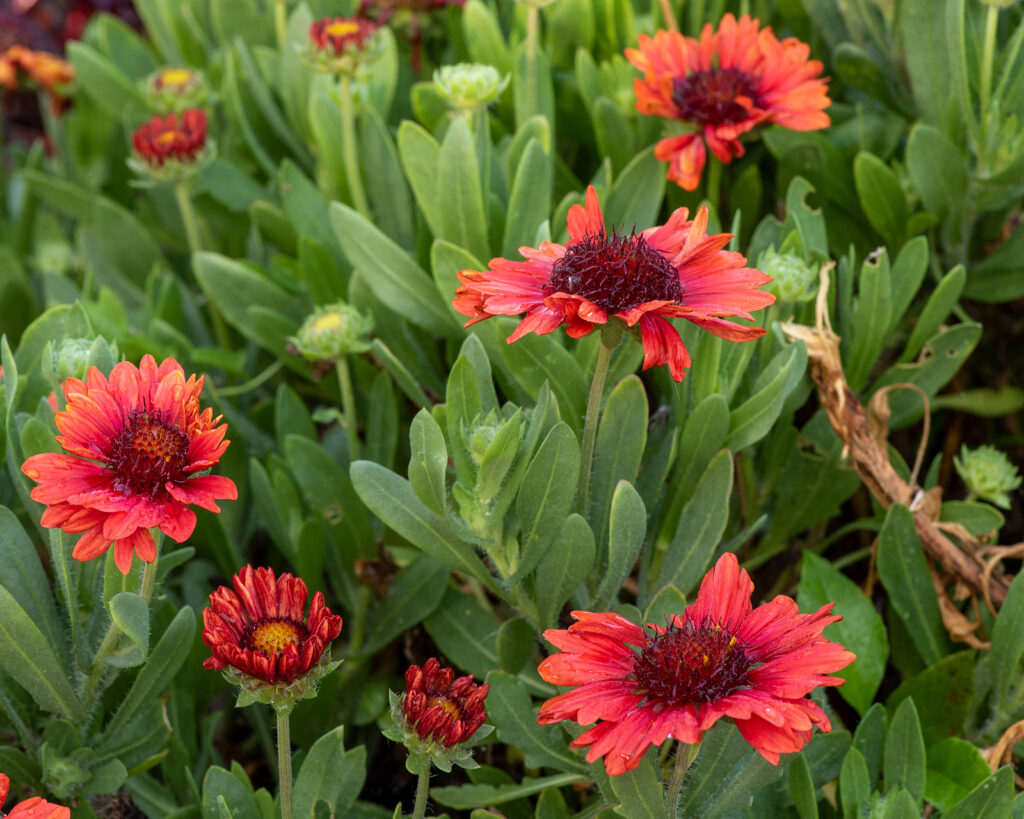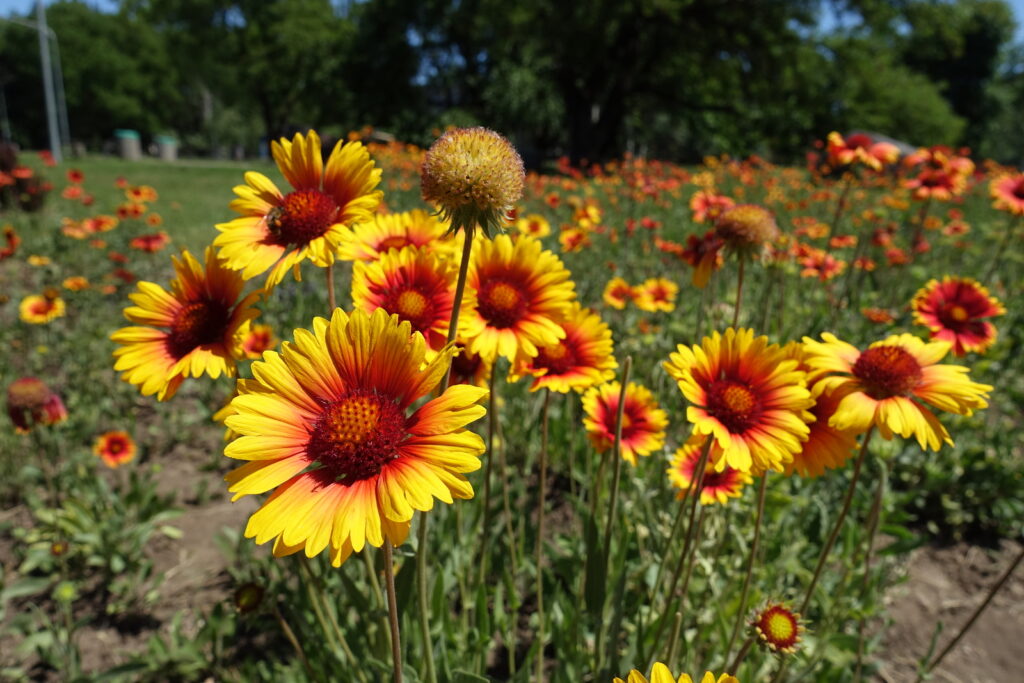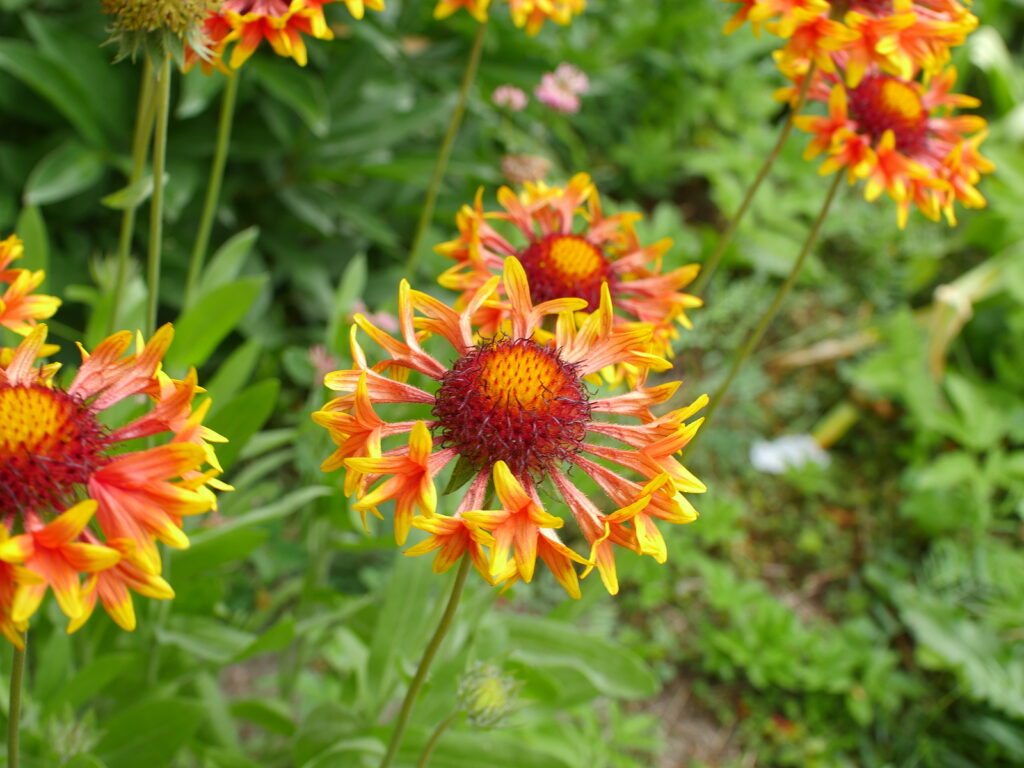Gaillardias are short-lived perennials and annuals grown for their long-lasting brightly colored daisy-like flowers that appear from summer into early fall. Gaillardias bear single and double flowers in shades of red, red-orange, maroon, and yellow.
There are about 30 species of Gaillardias. They are native to central and western North America. Most Gaillardias grown in gardens are hybrids developed to bear large blooms, 3 to 5 inches (7.6-12cm) wide.
Good Products for Garden Health at Amazon:
- Garden Safe Snail and Slug Bait
- Bonide Sulfur Fungicide
- Monterey BT Caterpillar Killer
- Neem Bliss 100-% Cold Pressed Neem Oil
- Safer Brand Insect Killing Soap
- PyGanic Botanical Insecticide
Gaillardias are members of the Aster family. They bear rosettes of hairy leaves topped by single or double daisy-like flowers. Perennial Gaillardias commonly live for three to five years.
Gaillardias are easy to grow from seed. They are a colorful choice for borders and cutting. They often reseed.

Get to know Gaillardia
- Plant type: Annuals and perennials
- Growing Zones and range: Zones 2 to 10
- Hardiness: Hardy to -35°F (-37°C); thrives in hot, warm, or cold climates
- Height and width: 10 to 36 inches (25-91cm) tall; 10 to 24 inches (25-61cm) wide, depending on the variety
- Foliage: Toothed or lobed slightly hairy leaves from basal rosettes
- Flowers: Daisylike, disk florets flowers
- Flower colors: Red, orange, yellow, and bicolors; double and semi-double blooms
- Bloom time: Summer through frost
- Uses: Beds, borders, wildflower gardens, and containers; seaside gardens (salt-tolerant), hillsides, raised beds, parking areas, sunny walkways, patios, and bare and dry spots (drought-tolerant)
- Common name: Blanket Flower, gaillardia
- Botanical name: Gaillardia spp.
- Family: Asteraceae
- Origin: North America
Where to plant Gaillardia
- Plant Gaillardia in full sun—tolerates heat and drought.
- Gaillardia grows best in average well-drained soil; poor, dry, and sandy soil is not a problem. Blanket flower prefers drier soil.
- Soil too rich will cause plants to be floppy.
- Gaillardia is drought and salt-tolerant.
- Gaillardia prefers a soil pH of 6.1 to 6.5.
Gaillardia uses and companions
- Mass Gaillardia for a colorful effect.
- Use Gaillardia in a cottage and informal gardens.
- Gaillardia can be included in wildflower plantings.
- Gaillardia is best matched with other hot-colored flowers.
- Good garden companions for Gaillardia are Achillea, Coreopsis, Hemerocallis, Linum, Solidago, and ornamental grasses.
When to plant Gaillardia
- Plant Gaillardia in spring; perennial varieties can be planted in fall.
- Sow seeds of annual Gaillardias indoors 6 to 8 weeks before the last frost in spring.
- Sow seed outdoors after the last frost. Gaillardia is easy to grow from seed.
- Set container-grown Gaillardia in the garden in spring and autumn.

Planting and spacing Gaillardia
- Sow seed indoors 1/8 inch deep in sterile seed starting mix or potting soil. Light aids germination, so gently press the seeds into the soil surface.
- Sow seed outdoors in evenly prepared soil.
- Space Gaillardia 1 to 2 feet (30-61cm) apart.
How to water and feed Gaillardia
- Water Gaillardia until the soil is deeply moist, then allow the soil to dry before watering again. Allow the soil to dry between watering.
- Established plants can tolerate dry soil.
- Fertilize Gaillardia lightly if at all. Use an all-purpose fertilizer.

Gaillardia care
- Trim Gaillardia spent blooms to keep the plant blooming.
- Taller plants may need staking.
- Gaillardia easily re-seeds itself so remove plants you don’t want.
Gaillardia pests and diseases
- Gaillardia is prone to powdery mildew and leafhoppers.
- Gaillardia is susceptible to crown rot in wet conditions.
- Downy mildew may attack the undersides of leaves causing them to turn yellow.
Gaillardia propagation
- Propagate Gaillardia by seed (see above), division, or stem cuttings taken in early summer.
- Seeds germinate in 14 to 21 days at 55°-64°F (13°-18°C).
- Propagate by rooting cuttings taken in winter. Grow cuttings in a cold frame before planting them in the open garden in spring.
- Divide perennial Gaillardia every 2 to 3 years in early spring.

Gaillardia varieties to grow
- G. aristata, blanket flower: Perennial wildflowers can grow to 30 inches (76cm) tall and spread to 24 inches wide; 4-inch-wide flowers with red-orange centers and yellow petals with lobes at the tips; blooms summer to fall.
- G. x grandiflora, blanket flower: Short-loved perennial to grow in Zones 2-10; grows 24 to 36 inches (60-91cm) tall; 3 to 5 inch wide flowers in a combination of reds, Maroon,s oranges, and y3llo2w from early summer to fall; dwarf cultivars grow 8 to 16 inches (20-40cm) tall.
- G. pulchella, blanket flower: Annual grows to 18 inches (45cm) tall; bears red, yellow, or red and yellow daisylike flowers to 2 inches wide with purple-black centers from summer to fall; grows in Zones 2-11. ‘Red Plume’ is an All-America Selection with dwarf habit and extended bloom time; ‘Yellow Sun’ produces dense mounds of foliage and bright yellow flowers.
Gaillardia frequently asked questions
Q: What conditions do Gaillardia like?
A: Gaillardia likes hot sun and dry soil. It needs very little fertilizer. It actually prefers infertile soil.















